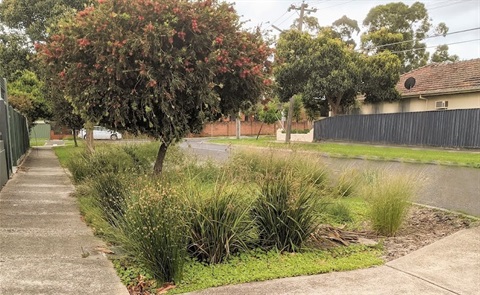Nature Strip Planting

Planting your nature strip with the right species is a great way to reduce long-term maintenance requirements while supporting biodiversity.
What is a nature strip?
The nature strip is the area of Council land located between your property, the footpath, and the street kerb, typically covered with grass.
They house underground services (such as gas, water, and power) and are the designated space for your bins on collection day.
Nature strips can be transformed into valuable natural spaces in urban environments, providing food for pollinators and helping to mitigate flooding. They also play a crucial role in keeping the street cooler on hot days.
Maintaining the nature strip
It is your responsibility to maintain your nature strip clear, tidy, and safe for pedestrians and vehicles.
We also encourage you to water newly planted street trees while being mindful of any water restrictions.
For a low-maintenance alternative, consider replacing the grass with indigenous plant species. Keep reading to learn more.
Planting on the nature strip
If you wish to plant on your nature strip, please follow these steps:
1. Read our Nature Strip Planting Guidelines:
Make sure you are familiar with Darebin’s Nature Strip Planting Guidelines(PDF, 603KB).
2. Choose your species:
- Recommended plants: Select from our list of recommended nature strip species. Indigenous plants are better adapted to local conditions than native and exotic plants, requiring less maintenance and supporting local wildlife.
- Indigenous Nurseries: Visit a local indigenous nursery to find the best-suited plants for your nature strip:
Nangak Tamboree La Trobe Indigenous Plant Nursery
La Trobe Ave, Trobe University, Bundoora Campus
Phone: 03 9479 1206
Email: wildlife@latrobe.edu.au
Victorian Indigenous Nurseries Co-Op (VINC)
Yarra Bend Road, Fairfield, 3078
Phone: 03 9482 1710
Email: retail@vinc.net.au
3. Verify what is not allowed:
- Street trees: You cannot plant your own street tree on the nature strip, that is our function. Find out more about street trees or contact Customer Service to request a new tree.
- Planting near trees: Do not plant within 60 cm of street trees to allow for proper tree maintenance.
- Installations: Do not install irrigation systems, artificial turf, or raised structures.
- Hazardous plants: Avoid planting spiky species like succulents or cacti, which may pose risks to pedestrians if overgrown.
4. Apply for a planting permit:
Once you have reviewed the above information, apply for a nature strip planting permit by completing a Nature Strip Approval Form:
Nature Strip Approval Form
- Automatic Approval: If all requirements are met, you will automatically receive a Nature Strip Planting Permit.
FAQ's
What happens if Council or a utility company need to access the services within my landscaped nature strip?
- The nature strip contains essential services such as telephone, gas, water, sewerage, drainage, and electricity.
- Utility companies may need to access their infrastructure for upgrades or repairs.
- Be aware that these companies are only required to reinstate the nature strip as grass, even if you have obtained a Nature Strip Planting Permit.
What would happen if a property with a Nature Strip Planting Permit is sold?
- If the property is sold and the new owners do not wish to maintain the planted nature strip, the previous owner must return it to its original condition at their own expense.
- Alternatively, the new owners can agree to maintain the planted nature strip by obtaining a Nature Strip Planting Permit through our webpage.
More information
For more information, please email darebinparks@darebin.vic.gov.au.